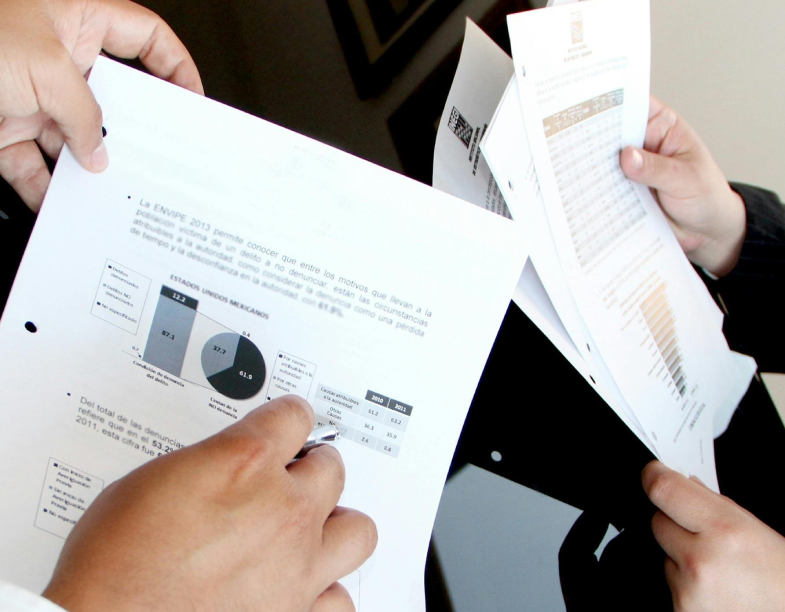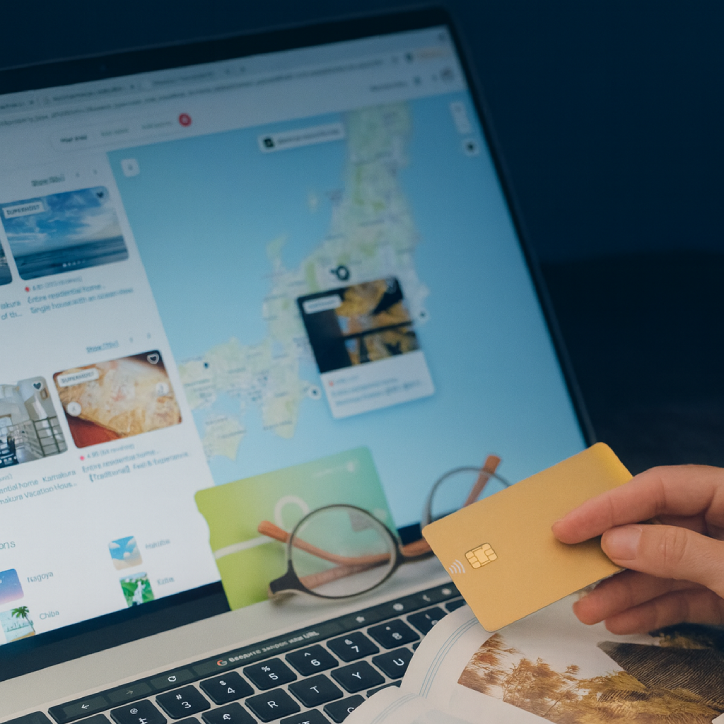Back to all Articles
Karol Andruszków
Karol is a serial entrepreneur who has successfully founded 4 startup companies. With over 11 years of experience in Banking, Financial, IT and eCommerce sector, Karol has provided expert advice to more than 500 companies across 15 countries, including Poland, the USA, the UK, and Portugal.
Top Marketplace Payment Solutions by Platform Type
Updated:
Wed, Jun 25
Czas czytania: 11 minut
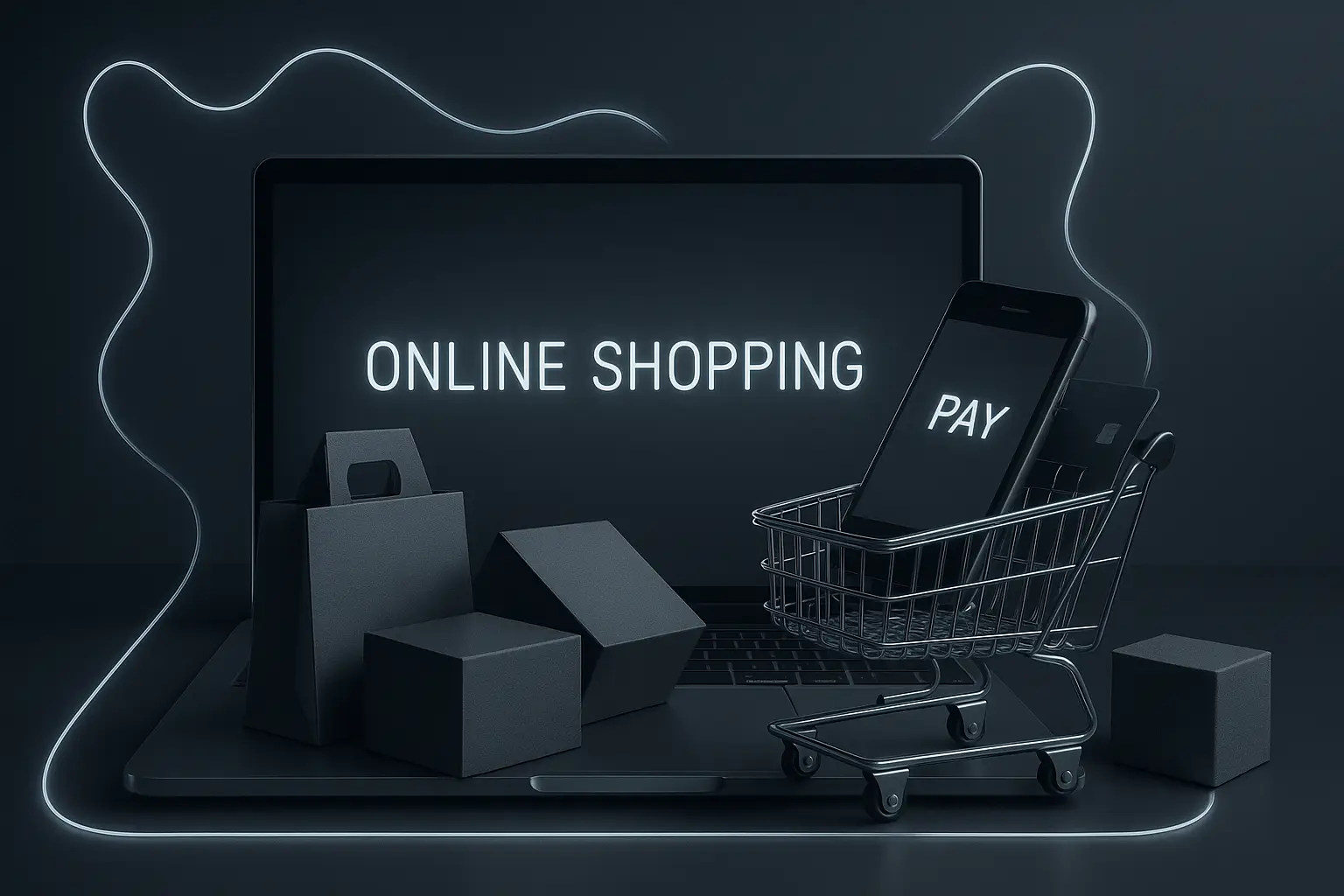
Have you seen how many payment solution providers are out there right now? Fifty? A hundred?
Depending on how you count, but probably even more. No surprise it’s easy to get lost in a sea of promises like fast payouts, global reach, seamless onboarding, compliance out of the box.
But here’s the thing: not every payment solution fits every type of marketplace.
That was a reason why we have decided to write this article to help make sense of it all.
You’ll find a breakdown of the best marketplace payment solutions by platform type, based on our opinion.
Running a B2C marketplace means navigating thousands of micro-transactions between individual buyers and sellers. Each one carrying legal, financial, and UX implications.
Customers expect fast checkout. Sellers need quick access to funds. And your team needs to manage risk, refunds, and regulatory requirements. Let's look at what solutions are build to achieve exactly that.
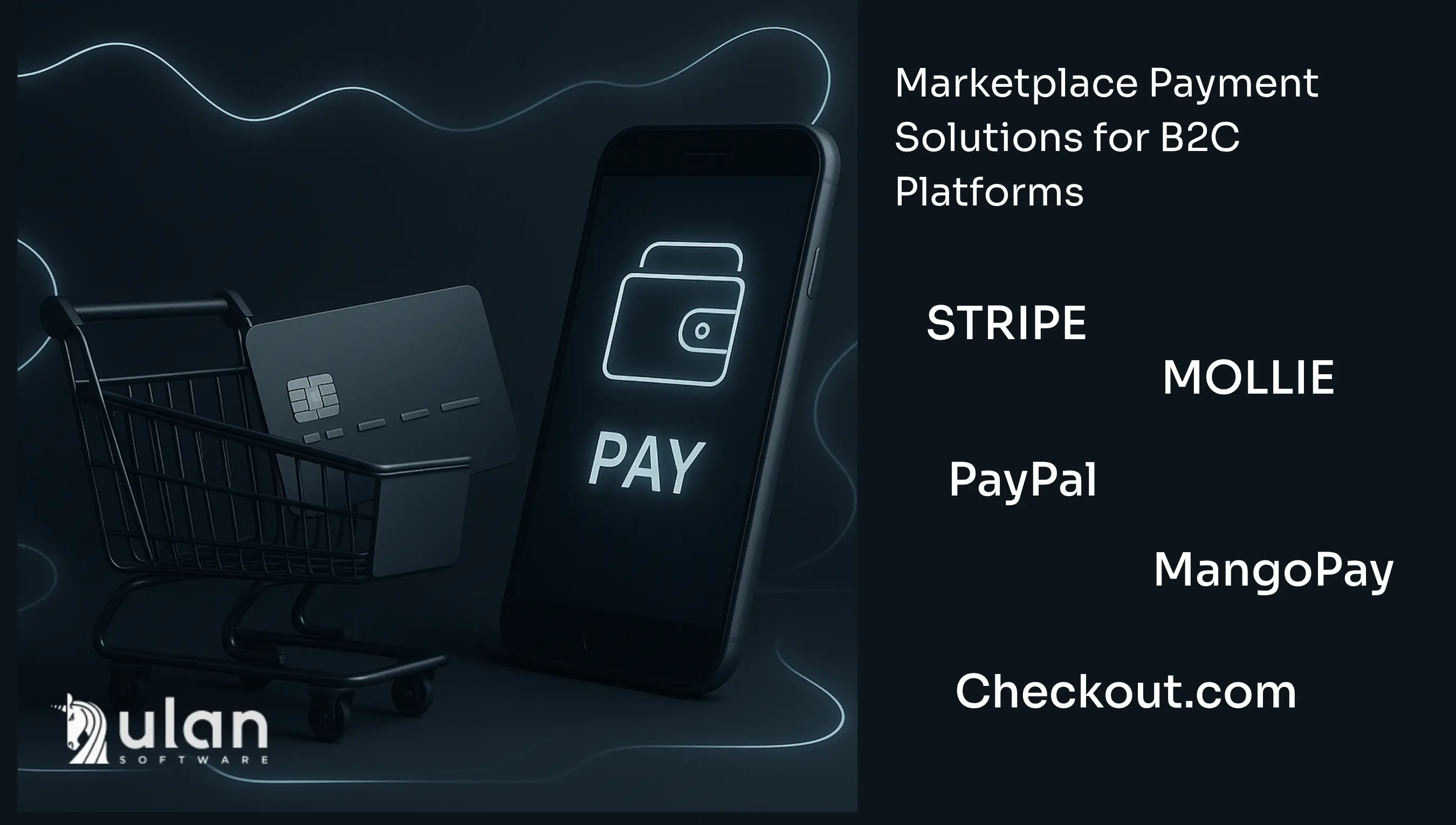
The biggest advantage? Control.
You can choose between Standard, Express, or Custom accounts depending on how much of the user experience you want to own. Stripe supports 135+ currencies, dozens of local payment methods, and can handle payouts in over 45 countries. This is the perfect option for marketplaces with international buyers or sellers.
As of 2025, it’s used by over 15,000 platforms and supports more than 10 million connected accounts.
One thing to watch. Stripe is highly developer-oriented. You’ll need engineering resources to set it up and maintain it.
Here you can learn more about our hands-on experience with stripe integrations.
Depending on how you count, but probably even more. No surprise it’s easy to get lost in a sea of promises like fast payouts, global reach, seamless onboarding, compliance out of the box.
But here’s the thing: not every payment solution fits every type of marketplace.
That was a reason why we have decided to write this article to help make sense of it all.
You’ll find a breakdown of the best marketplace payment solutions by platform type, based on our opinion.
Why Choosing the Right Payment Solution is Crucial
Behind every successful marketplace is a payment flow users barely notice.
Each marketplace model has unique demands. A B2C platform needs instant checkout and smooth refunds. B2B marketplaces often deal with high-value invoices, delayed settlements, and complex compliance. P2P platforms rely on trust, speed, and mobile-first to keep users engaged.
That’s why choosing the right partner from today’s mix of digital payment solutions, integrated payment solutions, and mobile payments solutions is so critical.
Each marketplace model has unique demands. A B2C platform needs instant checkout and smooth refunds. B2B marketplaces often deal with high-value invoices, delayed settlements, and complex compliance. P2P platforms rely on trust, speed, and mobile-first to keep users engaged.
That’s why choosing the right partner from today’s mix of digital payment solutions, integrated payment solutions, and mobile payments solutions is so critical.
Best Marketplace Payment Solutions for B2C Platforms
Customers expect fast checkout. Sellers need quick access to funds. And your team needs to manage risk, refunds, and regulatory requirements. Let's look at what solutions are build to achieve exactly that.

Stripe Connect
Stripe Connect is a favorite among startups and mid-sized online marketplaces across the US and EU. Its flexible API enables split payments, automated seller onboarding, and built-in compliance handling. That makes it a perfect fit for gig economy platforms, e-commerce sites, and even crowdfunding models.The biggest advantage? Control.
You can choose between Standard, Express, or Custom accounts depending on how much of the user experience you want to own. Stripe supports 135+ currencies, dozens of local payment methods, and can handle payouts in over 45 countries. This is the perfect option for marketplaces with international buyers or sellers.
As of 2025, it’s used by over 15,000 platforms and supports more than 10 million connected accounts.
One thing to watch. Stripe is highly developer-oriented. You’ll need engineering resources to set it up and maintain it.
Here you can learn more about our hands-on experience with stripe integrations.
PayPal & Braintree
PayPal, together with its Braintree gateway, became an integral part in e-commerce payment solutions. Many users already have PayPal accounts, which makes checkout feel safer and faster.
Braintree allows you to accept PayPal, credit/debit cards, and other digital wallets (Apple Pay, Google Pay) in one integration. While Braintree previously offered its own Marketplace tools for split payments, PayPal has now shifted toward partner programs and integrations with providers like Mollie.
However, for some PayPal can be expensive. Fees stack up quickly, especially for multi-party payments. Still, it’s a strong option to combine with other online payment solutions if fast launch and buyer trust are top of your priorities.
Mangopay
Mangopay is a top choice for EU-based B2C and C2C marketplaces. It offers e-wallets, KYC checks, escrow, and multi-currency payouts.
Mangopay holds an EU e-money license. This lets the provider manage funds and handle compliance for the marketplace.
More than 2,500 European platforms, like second-hand or crowdfunding sites, use Mangopay. It supports bank transfers through SEPA, SWIFT, and Faster Payments.
Integration is simple but less flexible than Stripe. Mangopay fits best when a marketplace wants to reduce payment work and stay focused on its main business.
Mollie Connect
Mollie Connect is as a simpler, more user-friendly alternative to Stripe Connect.
It offers access to many local and global payment methods including PayPal, Klarna, and others . All of them without needing separate integrations. This makes it easier for marketplaces to launch and offer the payment choices customers expect.
Mollie is known for easy merchant onboarding, clear dashboards, and a developer-friendly API. For small to mid-sized European marketplaces, this can be a big advantage.
It’s best suited for platforms focused on B2C sales, where fast setup and wide payment coverage matter more than deep customization.
Checkout
Checkout.com is a UK-based payment provider. It offers marketplace payment tools and strong card processing. Many large startups and scale-ups in Europe choose Checkout as an alternative to Stripe or Adyen.
The key strengths? Fast card payments, detailed reporting, and reliable global coverage. Checkout works best for B2C marketplaces that need scalable, high-performance payments and have a tech team ready to manage integrations.
Crypto Payment Processors
Some B2C marketplaces, especially those selling digital goods or serving niche communities, now accept cryptocurrency or stablecoins. Providers like Coinbase Commerce or Circle make this possible.
Crypto payments are not yet mainstream in the EU or US. However, they can help global platforms cut bank transfer fees, especially for paying contractors.
Best Marketplace Payment Solutions for B2B Platforms
B2B marketplaces handle large transactions, delayed payments, and strict compliance rules.
Unlike B2C, they often work with invoices, purchase orders, and negotiated deals. Choosing the right payment solution is key to managing high-value flows, complex settlements, and global partners.
Below are some of the best payment providers for B2B marketplaces in 2025.
Unlike B2C, they often work with invoices, purchase orders, and negotiated deals. Choosing the right payment solution is key to managing high-value flows, complex settlements, and global partners.
Below are some of the best payment providers for B2B marketplaces in 2025.
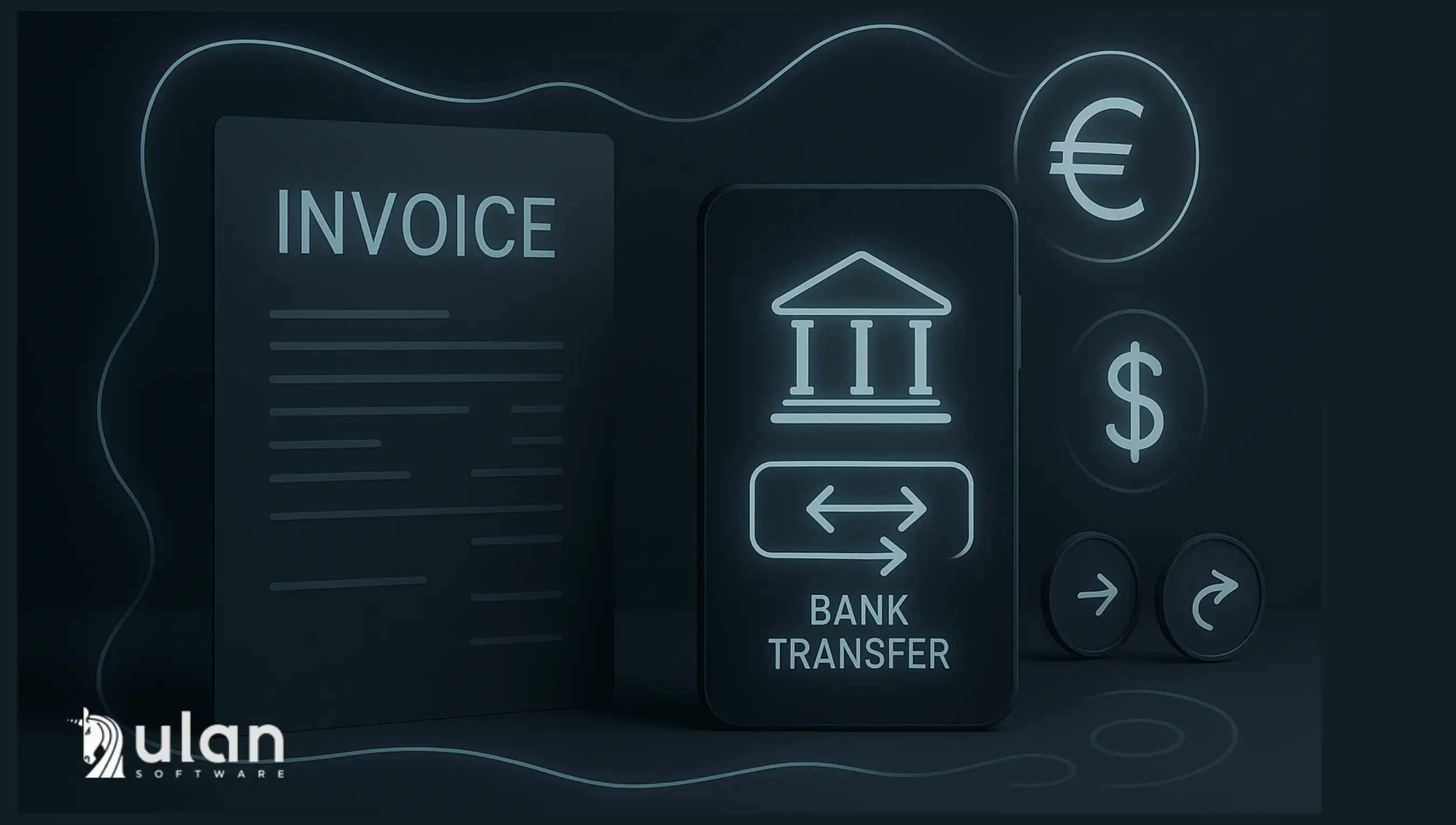
Adyen
Adyen is the heavyweight in enterprise-grade digital payment solutions.It supports everything from web checkout and in-app payments to point-of-sale. They making it a true omnichannel option.
What sets Adyen apart:
- Built-in support for 150+ local payment methods
- Direct bank integrations for real-time payments
- Ability to hold funds in sub-accounts (thanks to its EMI license in Europe)
Adyen is a payment processing solution that handles compliance, FX conversion, and fraud prevention at scale. It’s particularly strong in complex, multi-region environments and high-volume operations.
Open Banking and Pay-by-Bank Providers
Providers like TrueLayer, Tink, and Trustly help marketplaces offer direct bank payments. These services use Open Banking APIs or local instant payment systems.
Account-to-account (A2A) payments cost less than card payments. This makes them a good choice for industries with thin margins or for B2B marketplaces with large transactions.
For example, a B2B supply marketplace can use Trustly to let buyers pay by bank transfer. The seller then gets the funds right away.
In the EU and UK, Open Banking use is growing, inspired by Brazil’s Pix system. Providers like Vyne or GoCardless also help send fast payouts to bank accounts.
These tools can work alongside card processors, giving buyers a “Pay by Bank” option at checkout. They are best for marketplaces that want a low-cost, fast payment choice and operate in fintech-friendly regions.
Dedicated Payout Platforms
Tipalti, Trolley, Hyperwallet, and Payoneer help marketplaces send money to people or businesses across the world. These tools handle the hard parts, like tax forms, local bank rules, and multi-currency payments.
For example, Tipalti collects W-8 and W-9 tax forms, supports 120+ currencies, and pays out by ACH, wire, PayPal, or even checks. Payoneer, used by many freelance platforms, offers prepaid cards and local bank transfers in many countries.
These payout platforms are perfect when a marketplace needs to pay thousands of sellers or contractors. Many platforms use Stripe or Adyen to take payments from buyers, but then use Tipalti or Payoneer to send out the money, especially when card payouts are not enough.
They work best for B2B marketplaces or service platforms, where each person might want a different way to get paid. These tools also help with compliance checks, so the marketplace team has less work to do.
Custom In-House Solution
Some big marketplaces, like Amazon, build their own payment systems. They manage payments and work with many providers to lower costs.
This path only makes sense for large companies with big budgets and strong tech teams.
Most other marketplaces gain more by using a payment provider than by building their own system.
Emerging Trends in Marketplace Payments
Marketplace payments are changing fast. In 2025, several trends are shaping how platforms handle money and meet user needs. These trends affect both how marketplaces work and what buyers and sellers expect.
Below are the key shifts every marketplace team should watch.
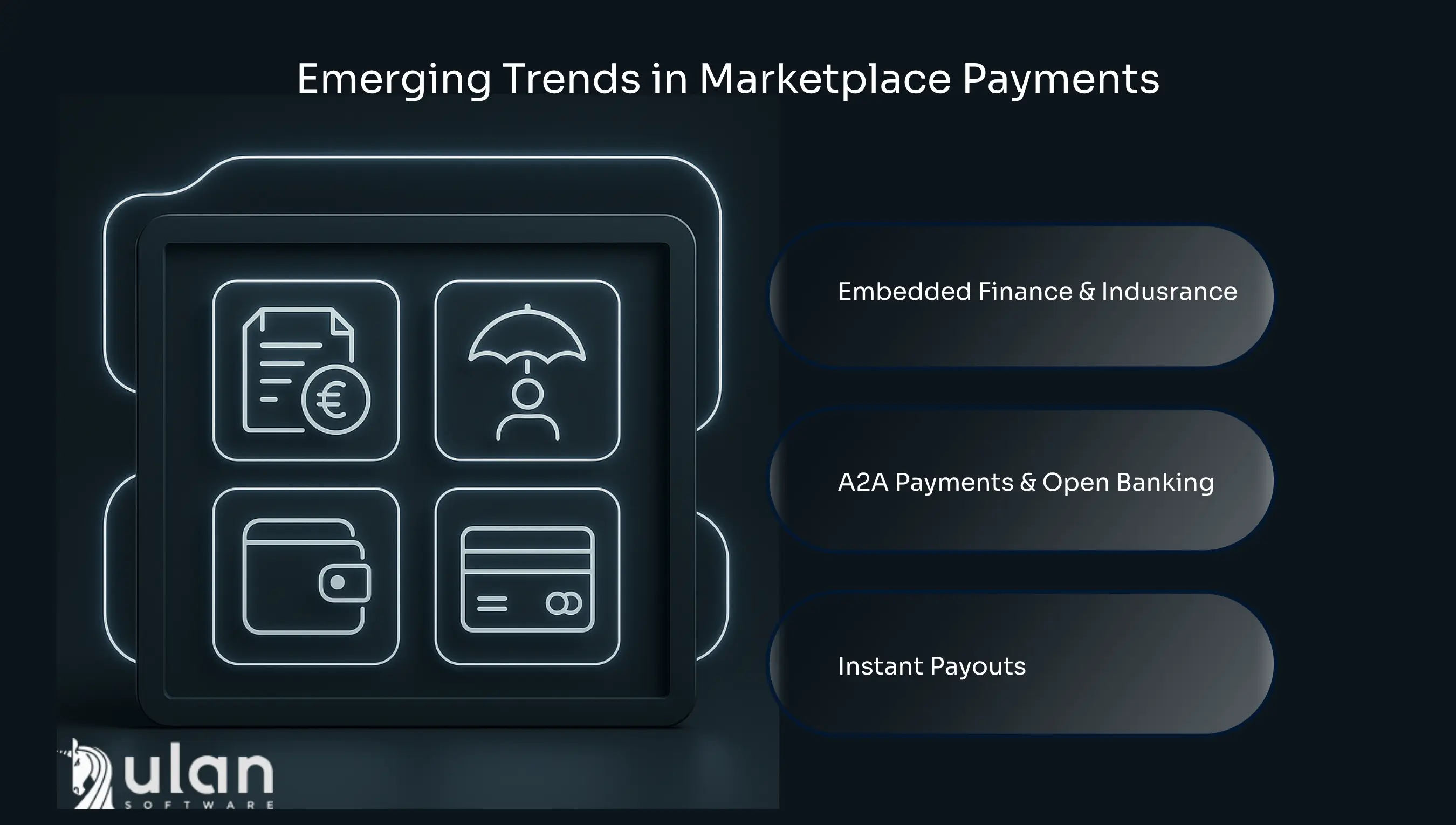
Industry experts predict that:
Below are the key shifts every marketplace team should watch.

Embedded Finance on Marketplaces
Marketplaces now embed financial services to bring more value to users. This includes lending, insurance, wallets, and even banking tools built right into the platform.Industry experts predict that:
“Embedded Finance will play a larger role, with more platforms offering in-platform lending, insurance, and investment options for sellers.”
David Maret, Senior Partnership & Customer Success Manager, Nuvei for Platforms
For example, a marketplace might offer sellers advance payouts or loans based on sales history. We already see this in action:
Payment providers support this change too. Stripe Capital and PayPal Working Capital are tools that marketplaces can use to help sellers. Another trend is issuing payment cards tied to seller earnings. Stripe Issuing, for instance, lets platforms create expense cards so sellers can spend directly from their balance.
Insurance is part of the picture as well. Travel marketplaces now offer trip insurance at checkout. Freelancer platforms may offer equipment insurance to providers.
In the article Top 9 Embedded Finance Examples and How They Work we break down how these services are changing buying across industries.
These embedded services make a marketplace more “sticky”. So users stay longer, and the platform earns new revenue through fees or commissions.
- Uber offers drivers cash advances.
- Amazon lends money to sellers.
- Shopify (while not a marketplace) gives merchants access to loans.
Payment providers support this change too. Stripe Capital and PayPal Working Capital are tools that marketplaces can use to help sellers. Another trend is issuing payment cards tied to seller earnings. Stripe Issuing, for instance, lets platforms create expense cards so sellers can spend directly from their balance.
Insurance is part of the picture as well. Travel marketplaces now offer trip insurance at checkout. Freelancer platforms may offer equipment insurance to providers.
In the article Top 9 Embedded Finance Examples and How They Work we break down how these services are changing buying across industries.
These embedded services make a marketplace more “sticky”. So users stay longer, and the platform earns new revenue through fees or commissions.
Even with great technology and compliance, poor payment UX can break a marketplace. In 2025, platforms are focusing on reducing friction. Especially during seller onboarding and buyer checkout.
By 2025, many marketplaces let customers skip cards and use instant bank transfers through apps. This cuts fees and gives instant payment confirmation.
In the UK, Open Banking payments are expanding. Europe has local options like iDEAL in the Netherlands and Sofort in Germany.
Real-time payment systems are also growing. The US launched FedNow in 2023, Europe has SEPA Instant, and Brazil’s Pix system shows the power of instant bank payments, with 80% of adults using it.
Marketplaces can connect to fintech APIs like Plaid or TrueLayer to enable these payments. Many now add A2A options next to cards. This works well for big purchases or in areas where cards are less common but bank accounts are widespread.
Payment providers now offer tools to meet this need. Visa Direct and Mastercard Send let marketplaces push funds to debit cards in real time. Stripe, PayPal, and others offer similar instant payout services for a fee.
In the US, networks like RTP and FedNow make it possible to move money to sellers’ bank accounts within seconds, even on weekends. Europe is moving in the same direction with systems like Visa Fast Funds and SEPA Instant.
For marketplaces, faster payouts are now a competitive edge. But they come with risks. Platforms must manage chargeback risk and often limit instant payouts to cleared funds.
Some marketplaces use in-app earnings wallets to hold funds. Sellers can then trigger an instant transfer when they want, sometimes paying a small fee.
A big trend is closer collaboration between platforms and payment networks. For example, Visa’s new Acquirer Monitoring Program (VAMP) tracks fraud and chargebacks on marketplaces. Visa’s purchase of AI fraud firm Featurespace also signals that advanced AI tools will play a bigger role in fraud detection.
Marketplaces now use fraud detection tools from providers or third parties like Ravelin and Sift. A 2025 report shows that payment networks and merchants are investing in AI and machine learning for fraud checks.
Data sharing is also increasing. Platforms now feed more details to risk engines, such as product types and buyer locations, helping systems spot unusual patterns.
Authentication is improving too. Biometrics (face, fingerprint) and 3-D Secure 2.x with smoother flows help reduce fraud without slowing down payments. To stop deepfake fraud, platforms use “liveness checks”, which means asking users to take live selfie videos during KYC.
Another trend is the emergence of subscription and membership models within marketplaces. Platforms offering “subscribe and save” across vendors need recurring payment setups, including stored payment details and subscription billing tools.
Buy Now, Pay Later (BNPL) remains popular. Marketplaces can partner with BNPL providers like Affirm, Klarna, or Afterpay to offer installment payments. For example, Mollie’s 2024 integration with Riverty shows that “pay in 30 days” is now seen as a key add-on in Europe.
Multi-currency pricing and local acquiring also matter. Marketplaces want to show prices in local currencies and process payments locally to avoid FX fees.
Account-to-Account Payments and Open Banking
“Pay-by-bank” methods are gaining ground, especially in Europe. Thanks to PSD2 and Open Banking, licensed platforms can now move money straight from customer bank accounts, with consent.By 2025, many marketplaces let customers skip cards and use instant bank transfers through apps. This cuts fees and gives instant payment confirmation.
In the UK, Open Banking payments are expanding. Europe has local options like iDEAL in the Netherlands and Sofort in Germany.
Real-time payment systems are also growing. The US launched FedNow in 2023, Europe has SEPA Instant, and Brazil’s Pix system shows the power of instant bank payments, with 80% of adults using it.
Marketplaces can connect to fintech APIs like Plaid or TrueLayer to enable these payments. Many now add A2A options next to cards. This works well for big purchases or in areas where cards are less common but bank accounts are widespread.
Instant Payouts and Faster Settlements
On-demand marketplaces and gig platforms have set a new standard: workers want instant payouts, not weeks of waiting.Payment providers now offer tools to meet this need. Visa Direct and Mastercard Send let marketplaces push funds to debit cards in real time. Stripe, PayPal, and others offer similar instant payout services for a fee.
In the US, networks like RTP and FedNow make it possible to move money to sellers’ bank accounts within seconds, even on weekends. Europe is moving in the same direction with systems like Visa Fast Funds and SEPA Instant.
For marketplaces, faster payouts are now a competitive edge. But they come with risks. Platforms must manage chargeback risk and often limit instant payouts to cleared funds.
Some marketplaces use in-app earnings wallets to hold funds. Sellers can then trigger an instant transfer when they want, sometimes paying a small fee.
Higher Standards for Fraud Prevention
Fraud threats are rising. Marketplaces and payment providers are stepping up their defenses.A big trend is closer collaboration between platforms and payment networks. For example, Visa’s new Acquirer Monitoring Program (VAMP) tracks fraud and chargebacks on marketplaces. Visa’s purchase of AI fraud firm Featurespace also signals that advanced AI tools will play a bigger role in fraud detection.
Marketplaces now use fraud detection tools from providers or third parties like Ravelin and Sift. A 2025 report shows that payment networks and merchants are investing in AI and machine learning for fraud checks.
Data sharing is also increasing. Platforms now feed more details to risk engines, such as product types and buyer locations, helping systems spot unusual patterns.
Authentication is improving too. Biometrics (face, fingerprint) and 3-D Secure 2.x with smoother flows help reduce fraud without slowing down payments. To stop deepfake fraud, platforms use “liveness checks”, which means asking users to take live selfie videos during KYC.
Checkout and Alternative Payments
Checkout is changing fast. Social commerce is growing, with in-app marketplaces on TikTok and Instagram. This pushes marketplaces to support one-click options like Meta Pay, Apple Pay, and Google Pay.
Another trend is the emergence of subscription and membership models within marketplaces. Platforms offering “subscribe and save” across vendors need recurring payment setups, including stored payment details and subscription billing tools.
Buy Now, Pay Later (BNPL) remains popular. Marketplaces can partner with BNPL providers like Affirm, Klarna, or Afterpay to offer installment payments. For example, Mollie’s 2024 integration with Riverty shows that “pay in 30 days” is now seen as a key add-on in Europe.
Multi-currency pricing and local acquiring also matter. Marketplaces want to show prices in local currencies and process payments locally to avoid FX fees.
Key Takeaways
As you learned, marketplace platform type, user needs, and growth goals shape what works best.
B2C marketplaces need fast checkout, smooth refunds, and wide payment options. B2B platforms demand flexible invoicing, large transfers, and strong compliance.
Emerging trends like embedded finance, instant payouts, A2A payments are changing user expectations.
If you want help assessing your payment setup or planning improvements, reach out to our team! We’re happy to share insights from real-world experience.
B2C marketplaces need fast checkout, smooth refunds, and wide payment options. B2B platforms demand flexible invoicing, large transfers, and strong compliance.
Emerging trends like embedded finance, instant payouts, A2A payments are changing user expectations.
If you want help assessing your payment setup or planning improvements, reach out to our team! We’re happy to share insights from real-world experience.
Karol Andruszków
Karol is a serial entrepreneur who has successfully founded 4 startup companies. With over 11 years of experience in Banking, Financial, IT and eCommerce sector, Karol has provided expert advice to more than 500 companies across 15 countries, including Poland, the USA, the UK, and Portugal.
Table of Contents:
Recommended Articles
Tue, Nov 25
How to Choose the Best Marketplace Software?
Learn how to choose the best marketplace software with a clear, step-by-step guide. Compare models, features, scale, cost, and vendor fit to make a confident choice.
Thu, Nov 20
Top 15 UX Tips to Improve Conversion Rates in Travel Booking
Improve travel booking flow conversion with 15 proven UX tips. Learn how mobile design, pricing clarity, speed, and smart flows reduce friction and lift bookings.
Mon, Nov 17
What to Look for in Enterprise Booking Software?
Learn what to look for in enterprise booking software: key features, integrations, security, and data to guide your 2025 selection.
